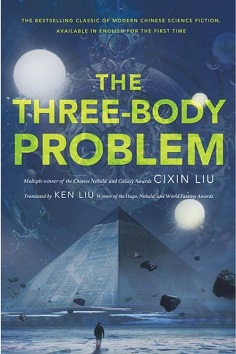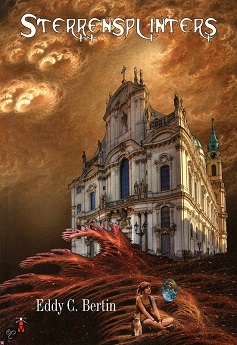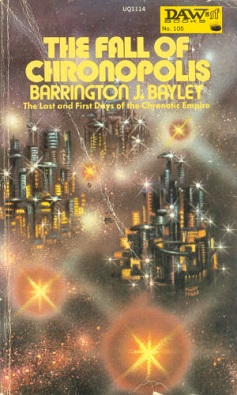
The Three-Body Problem
Cixin Liu
Translation by Ken Liu
302 pages
published in 2008 (English 2014)
If it hadn’t been for Marko Kloos doing the honourable thing and withdrawing his nomination, The Three-Body Problem wouldn’t be on the ballot for this year’s Best Novel Hugo. And that would’ve been a shame, since The Three-Body Problem is the first translated novel to make the shortlist. The start of a trilogy, it originally came out in China in serialisation in 2006, with the novel version coming out in 2008. The English translation was done by Ken Liu, who has won a Hugo Award himself. The sequels will come out this year and next.
What makes The Three-Body Problem almost missing out on the Hugo shortlist deeply ironic, is that it’s exactly the kind of oldfashioned hard science fiction the people behind this year’s vote rigging were supposed to be all in favour of. It revolves around the mystery of why all those physicists are killing themselves, the answer to which seems to be that fundamental principles of physics are broken… There are some great moments of sense of wonder, of conceptual breakthrough in it, as well as some characters Asimov would think were a bit two-dimensional.
The Three-Body Problem starts in the middle of the Cultural Revolution, introducing Ye Wenjie, whose physicist father is killed by Red Guards, young, fanatic followers of Mao fighting against what they see as the counter revolution. Her younger sister is part of the Red Guards and is killed in a fight with the regular army. Ye Wenjie herself, because of her family background and intellectual tendencies is banished to the countryside, working in a “volunteer” labour battelion. It’s while she’s working on deforesting part of Inner Mongolia to remake the forest into farmland, that she comes into contact with Rachel Carson’s Silent Spring, which will help provide the motivation for what she will do later. While under arrest for having the book on her, Ye Wenjie is recruited to help with the running of Red Coast, a secret PLA radio telescopy/listening post.
But just as her story seems to start, it moves to the present, with Ye Wenjie out of the picture until much later in the book. Instead we now follow Wang Miao, an academic working on nanotechnology, who is recruited by the socalled Battle Command Center, which turns out to be an international organisation, fighting a hidden war against an invisible enemy, a war fought against science. What the Battle Command Center in particular wants to know and needs him for is to understand why so many distinguished scientists and physicists have committed suicide.
In a scene that’s a direct homage to Isaac Asimov, a game of pool is used to first showcase the foundation of all physics/ We’ve discovered a great principle of nature: The laws of physics are invariant across space and time as one character puts it, before going on to explain that this is no longer the case:
“Imagine another set of results. The first time, the white ball drove the black ball into the pocket. The second time, the black ball bounced away. The third time, the black ball flew onto the ceiling. The fourth time, the black ball shot around the room like a frightened sparrow, finally taking refuge in your jacket pocket. The fifth time, the black ball flew away at nearly the speed of light, breaking the edge of the pool table, shooting through the wall, and leaving the Earth and the Solar System, just like Asimov once described.
That’s why scientists are committing suicide and what Wang Miao needs to figure out is who or what is behind it. This part of The Three-Body Problem reads like a techno thriller, as Wang Miao emerges himself in the conspiracy behind the suicides, getting cryptic hints from police captain Shi Qiang, rude and obnoxious but with a knack of saying just the right things to get Wang Miao to move forward.
It’s here that the central gimmick of the story is introduced, a virtual reality video game, Three Body in which Wang Miao is put in a world which vaguely resembles that of ancient China but with laws of physics that make no sense. His job and that of the other players is to figure these laws out and determine what’s going on.
Because I bought it as an ebook I read most of this in short snatches, frex waiting at the coffee machine at work. In retrospect, this hindered my comprehension of The Three-Body Problem‘s plot but helped my appreciation of the book as a whole. I would’ve seen most of the plot twists and shocking reveals coming, had I read it in a more sustained fashion, as Cixin Liu is far from subtle; indeed this has been one of the most common points of criticism leveled at The Three-Body Problem.
The Three-Body Problem of course refers to a classic physics problem and the virtual reality game has as its first goal to let its players figure out that the world they play in is subjected to this, a planet in a trinary solar system. Cixin Liu takes a while before he allows his protagonist to figure it out and perhaps it takes too long; a more observant reader would’ve gotten there much quicker.
Once that’s been figured out it’s a small step for characters and readers both to understand that the world of Three Body depicts an actual alien world and hence that aliens are behind the breakdown in physics. The rest of the novel revolves around understanding the history and gols of these aliens as well as what motivates their human collaborators. Which turns out to be an overwhelming sense of the failure of humanity to treat the world properly, so let somebody else try it, bringing the story back to Ye Wenjie, who turns out to have set everything in motion through her work at Red Coast.
In general The Three-Body Problem is an uneven book, oddly paced, with a build up in the first two parts that’s somewhat led down by its resolution in the third. What’s set up as a fundamental physicis problem basically turns into “aliens did it” with some technobabble about unfolding protons to make them into AIs. It’s a bit disappointing.
Also disappointing is the characterisation. The historical sections, telling Ye Wenjie’s story, are great, but every other character has to struggle to reach two dimensions. I don’t think this is a problem with the translation or differences between western and Chinese science fiction. Rather, there’s a reason Cixin Liu keeps reminding me of Isaac Asimov: he has a similar preferences for ideas over characterisation.
I didn’t read The Three-Body Problem in time to consider it for my Hugo ballot and I’m not sure I’d would’ve traded in one of my choices for this. The question now though, since it is on the Hugo shortlist, should I vote for it and if so, in which place? I won’t be upset if it does win the Best Novel Hugo, though I think I still prefer The Goblin Emperor over this.


